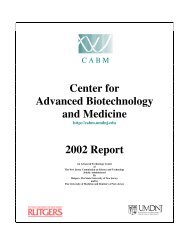Annual Report 2011 - Center for Advanced Biotechnology and ...
Annual Report 2011 - Center for Advanced Biotechnology and ...
Annual Report 2011 - Center for Advanced Biotechnology and ...
Create successful ePaper yourself
Turn your PDF publications into a flip-book with our unique Google optimized e-Paper software.
Dr. Aaron J. Shatkin<br />
Director of CABM<br />
Professor<br />
Department of Molecular<br />
Genetics, Microbiology <strong>and</strong><br />
Immunology<br />
UMDNJ-Robert Wood Johnson<br />
Medical School<br />
University Professor<br />
of Molecular Biology<br />
Rutgers University<br />
Dr. Weihua Qiu<br />
Research Associate<br />
Molecular Virology Laboratory<br />
Dr. Aaron J. Shatkin, a member of the National Academy of Sciences, has held<br />
research positions at the National Institutes of Health, The Salk Institute, <strong>and</strong> the<br />
Roche Institute of Molecular Biology. He has taught at Georgetown University<br />
Medical School, Cold Spring Harbor Laboratory, The Rockefeller University,<br />
UMDNJ-Newark Medical School, University of Puerto Rico, Princeton University <strong>and</strong><br />
other institutions. Shatkin was editor of the Journal of Virology from 1973-1977,<br />
founding editor-in-chief of Molecular <strong>and</strong> Cellular Biology from 1980-1990 <strong>and</strong> is<br />
currently editor of Advances in Virus Research. He has also served on the advisory<br />
boards of a number of organizations. In 1989 he was recognized by New Jersey<br />
Monthly magazine with a New Jersey Pride Award <strong>for</strong> his contributions to the State’s<br />
economic development. In 1991 the State of N.J. awarded Shatkin the Thomas Alva<br />
Edison Science Award, <strong>and</strong> he was selected as one of New Jersey’s top ten scientists<br />
by N.J. Business magazine. He was elected Fellow of the American Academy of Arts<br />
<strong>and</strong> Sciences in 1997 <strong>and</strong> the American Association <strong>for</strong> the Advancement of Science in<br />
1999. Shatkin received the 1977 National Academy of Sciences Molecular Biology<br />
Award, the 2003 Association of American Medical Colleges Award <strong>for</strong> Distinguished<br />
Research in the Biomedical Sciences, the Edward J. Ill Outst<strong>and</strong>ing Medical Research<br />
Scientist Award <strong>and</strong> from Robert Wood Johnson Medical School the R.W. Schlesinger<br />
Basic Science Mentoring Award in 2009 <strong>and</strong> the Honorary Alumnus Award in <strong>2011</strong>.<br />
mRNA 5'-capping<br />
One of the earliest steps in the cascade of events necessary <strong>for</strong> mRNA <strong>for</strong>mation <strong>and</strong><br />
function is the addition of a 5'-terminal m7GpppN "cap" to nascent RNA Polymerase<br />
II transcripts. This structural hallmark is present on most eukaryotic cellular as well<br />
as viral mR2NAs <strong>and</strong> is essential <strong>for</strong> viability. The presence of a cap enhances several<br />
downstream events in cellular gene expression including RNA stability, splicing of<br />
pre-mRNAs in the nucleus <strong>and</strong> initiation of protein synthesis in the cytoplasm. These<br />
important effects have fostered many studies that defined the enzymatic mechanisms<br />
of capping. We have cloned <strong>and</strong> sequenced the mouse <strong>and</strong> human capping enzymes<br />
(CEs, ~98% identical) <strong>and</strong> mapped the human protein to 6q16, a region implicated in<br />
tumor suppression. The 597-amino acid, 68kD mammalian polypeptides consist of<br />
two functional domains --N-terminal RNA 5' triphosphatase (RTase) <strong>and</strong> C-terminal<br />
guanylyltransferase (GTase). Mutational, biochemical <strong>and</strong> genetic analyses<br />
demonstrated that the GTase active site is a lysine in the sequence 294 Lys-X-Asp-<br />
Gly 297, one of several highly conserved motifs characteristic of a<br />
nucleotidyltransferase superfamily of proteins that includes other cellular <strong>and</strong> viral<br />
CEs. A haploid deletion strain of S. cerevisiae missing the guanylyltransferase<br />
enzyme was complemented <strong>for</strong> growth by the mouse wild type cDNA clone despite<br />
only ~25% sequence identity. However, a mouse clone containing alanine in place of<br />
lysine in the KXDG motif did not complement. The results demonstrated the<br />
functional conservation of CEs from yeast to mammals.<br />
We found that mammalian capping enzyme binds via its GTase region to the<br />
hyperphosphorylated C-terminal domain (CTD) of the largest subunit of RNA<br />
32



